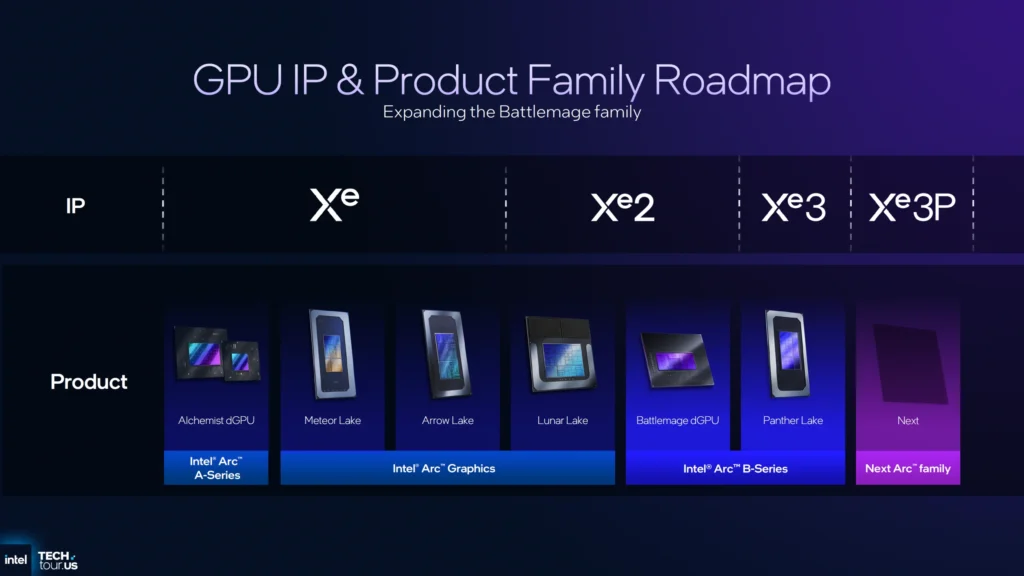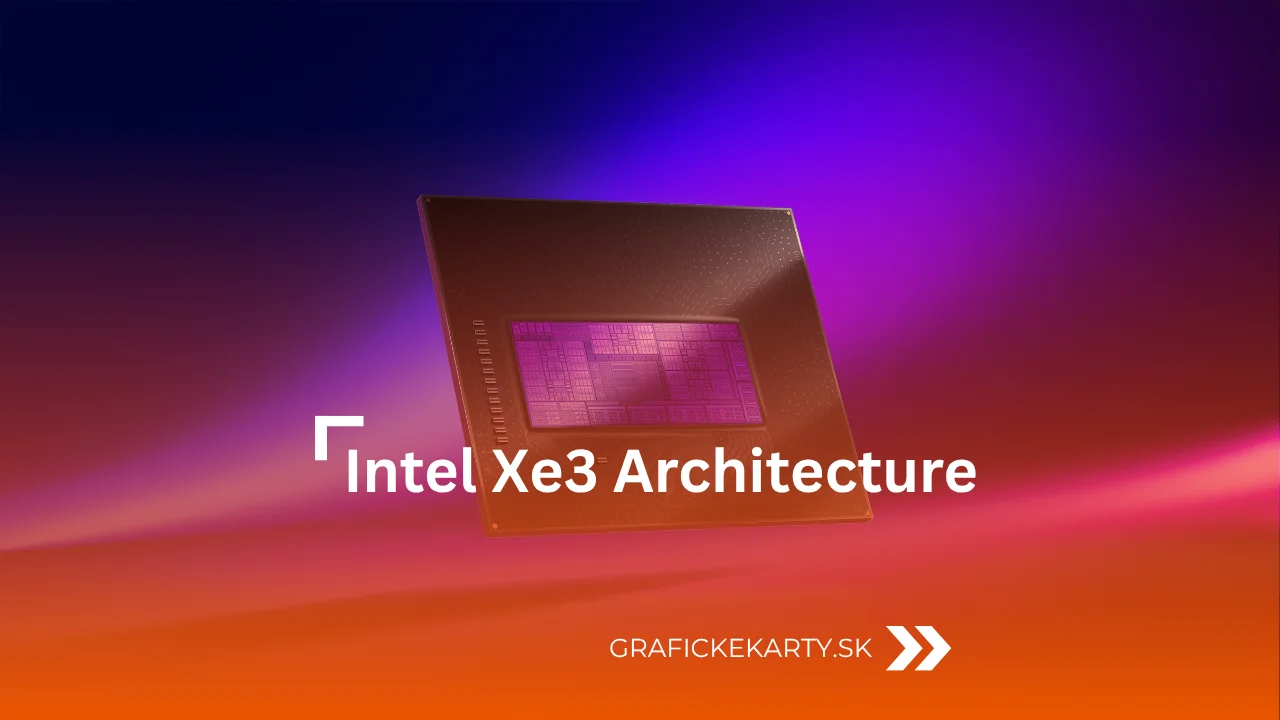The year 2025 brought an important step for Intel graphics. The company confirmed that Panther Lake processors will use Intel’s new Xe3 architecture, which will become the basis for the next generation of graphics within the Arc B-series family. The updated roadmap also reveals the upcoming Xe3P architecture, designed for the dedicated graphics cards of the next Next Arc Family line.
What the Intel Xe3 architecture brings
The Intel Xe3 architecture replaces the current Xe2 (Battlemage) and delivers higher performance, more efficient power usage and better scaling of compute units. Intel has focused on shader optimization, greater memory throughput, and accelerated ray tracing. In a configuration with 12 Xe Cores, Xe3 is expected to deliver approximately 50% more performance over the Lunar Lake (Xe2) solution.
The Intel Xe3 graphics core supports both LPDDR5X and GDDR6 memory and offers twice the compute density of Xe2. The power consumption of the integrated model in Panther Lake processors is expected to be around 25W, while dedicated Xe3P versions can achieve higher TDPs depending on the configuration.
The new architecture also works closely with the Neural Processing Unit (NPU) 4, which is part of the Panther Lake processors. The NPU accelerates AI computations and complements the GPU for tasks such as intelligent rendering, image upscaling or real-time denoising. The combination of CPU, GPU and NPU enables more efficient load sharing and lower power consumption for AI-based tasks.
The new Xe3 LPG (Low Power Graphics) chip will be used in Panther Lake processors for power-efficient notebooks, while the more powerful Xe3P version will serve as the basis for Next Arc Family dedicated graphics cards.

Arc B-series – a new common name for both iGPUs and dGPUs
Intel is now unifying its graphics products under a common brand, Arc B-series. This line includes integrated solutions in Panther Lake processors as well as standalone Arc Battlemage cards and future Xe3P models. The goal is to create a unified ecosystem – much like NVIDIA did with the GeForce RTX series.
Unified branding also benefits developers: common drivers, APIs and GUIs will ensure better compatibility across the entire portfolio – from power-efficient notebooks to gaming and workstations.
How Intel Xe3 differs from Xe2 (Battlemage)
Intel Xe3 represents the biggest step forward since the Xe HPG era. While Xe2 (Battlemage) focused on efficiency and ray tracing, Xe3 delivers more performance with more Xe cores per render unit, faster RT blocks, and a larger L2 cache. The architecture is ready for modern APIs such as DirectX 12 Ultimate and Vulkan 1.3, ensuring better support for the latest gaming and 3D engines. In practice, the integrated graphics in Panther Lake processors will also offer performance close to lower-end standalone cards, while maintaining low power consumption and quiet operation.
The new Xe3 LPG chip in Panther Lake processors will be targeted at power-efficient notebooks, while the more powerful Xe3P version will become the basis for the next generation of Next Arc Family dedicated cards, replacing Battlemage. Both versions belong to a single Intel Arc B-series line, unifying drivers, compatibility and Intel’s entire ecosystem – from integrated graphics to dedicated GPUs designed for gaming and creative deployments.
How Intel Xe3 is transforming gaming and professional performance
The new Intel Xe3 architecture is pushing the performance of graphics chips not only in gaming, but also in professional applications. With more compute cores, improved ray tracing and XeSS 2.0 technology, it can offer smoother gaming in both 1080p and 1440p while maintaining low power consumption. Gamers can enjoy more stable performance and lower latency, while content creators get faster rendering, shorter video exports and better 3D model handling in software such as Blender, Maya and DaVinci Resolve.
Compared to competitors AMD RDNA 4 and NVIDIA Blackwell , Intel delivers a unified platform advantage. The same architecture and drivers work across laptops, desktops and workstations, simplifying optimization and ensuring consistent performance across devices.
While NVIDIA is building on DLSS 4 and AMD on FSR 3, Intel is betting on its own XeSS 2.0 technology with a new Multi-Frame Generation (MFG) feature that enhances image smoothness without sacrificing quality. Combined with the AI acceleration in NPU 4 and the improved manufacturing efficiency of Intel 4, Xe3 thus offers a modern and more power-efficient solution. This makes Intel Xe3 an important step towards leveling the GPU playing field and moves Intel closer to the duopoly of NVIDIA and AMD.
Conclusion
The Intel Xe3 architecture represents an important step towards unifying Intel’s graphics ecosystem. The company has moved closer to the AMD and NVIDIA approach, where the same architectures power notebooks, desktops and integrated chips. This will bring better optimization, more stable drivers and higher performance across all devices.
For users, this means more efficient iGPUs in Panther Lake processors and more powerful dedicated Arc Xe3P cards with the same technology foundation. However, as the Xe3 architecture evolves and the first generation of Arc Xe3P cards arrive, new technical details and specification changes may yet emerge. We will be monitoring the situation closely and will report on any news that Intel brings in the coming months.
